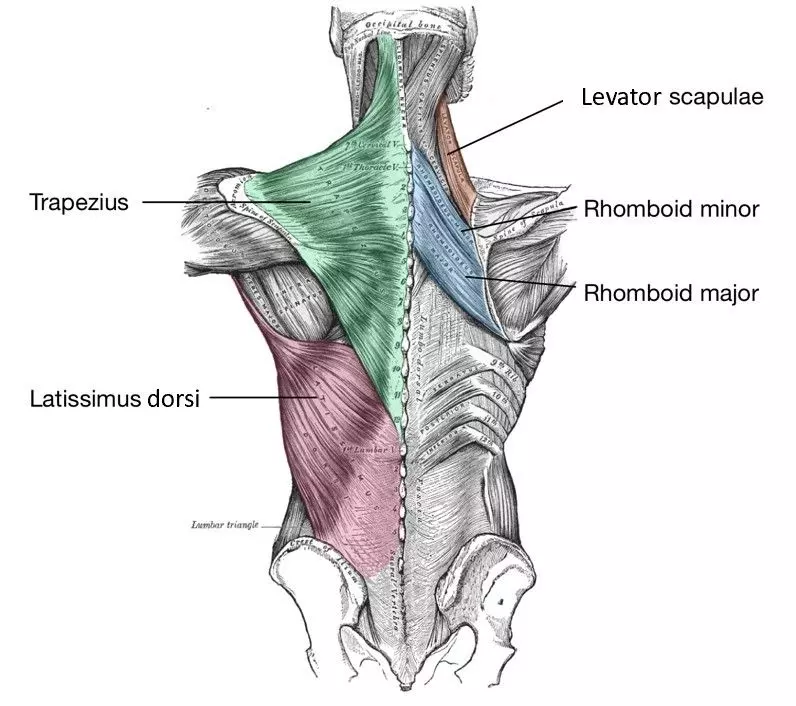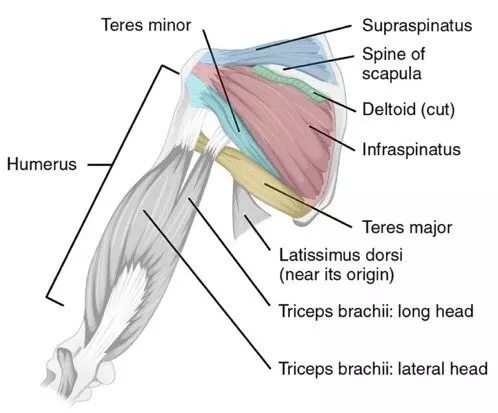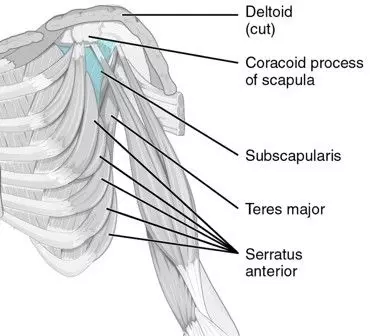Next Lesson - Muscles of the Upper Arm
Abstract
The shoulder joint is incredibly complex and can perform a wide range of movements. To allow for this, there are a large number of muscles that act at the shoulder joint. These muscles can be split into intrinsic and extrinsic muscles:
- Extrinsic – the extrinsic muscles can be split into:
- Superficial Posterior – trapezius and latissimus dorsi.
- Deep Posterior – levator scapulae, rhomboid major, rhomboid minor.
- Anterior - pectoralis major, pectoralis minor, serratus anterior.
- Intrinsic – Deltoid, teres major, teres minor, subscapularis, supraspinatus, infraspinatus.
Four of the intrinsic shoulder muscles are know as the rotator cuff muscles, and these are; teres minor, subscapularis, supraspinatus and infraspinatus.
Core
The shoulder joint is incredibly complex and is capable of a large range of movements. Therefore, to allow for maximum mobility, there are a large collection of muscles found in the shoulder region. These can be split into extrinsic and intrinsic muscles.
It is also very important when studying muscles that you are comfortable with anatomical terminology, as a lot is used in these articles. For more information, please check out our Anatomical Terminology Article.
These muscles originate from the posterior torso and attach to the shoulder. They can be split into two layers; superficial and deep.
Superficial Layer of Posterior Extrinsic Muscles
The superficial layer is composed of large, powerful muscles that originate from the spine and ascend to attach to bones of the shoulder. There are two muscles in the superficial layer:
Originates from the skull down, along the spinous processes of the vertebrae until T12. It attaches to the clavicle and the acromion and spine of the scapula. It is innervated by the accessory nerve (from the brachial plexus). Trapezius elevates the scapula, allowing for it to rotate during shoulder abduction.
Originates from the spinous process of T7 through to T12 in addition to the iliac crest. It attaches to the humerus, at the intertubecular sulcus. It is innervated by the thoracodorsal nerve. Latissimus dorsi acts to extend, adduct and medially rotate the humerus at the shoulder.
Deep Layer of Posterior Extrinsic Muscles
There are three muscles to know in the deep layer, they are all innervated by the dorsal scapular nerve:
Originates from the transverse processes of C1-C4, then it attaches to the medial scapula. It acts to elevate the scapula (as the name suggests).
Originate from the spinous process of C7-T1. It attachs to the medial scapula and acts to retract and rotate the scapula.
Originate from the spinous process of T2-T5 and attaches to the medial scapula, acting to retract and rotate the scapula.

Diagram - Illustration of extrinsic muscles of the shoulder
Creative commons source by Häggström, Mikael (2014). "Medical gallery of Mikael Häggström 2014". WikiJournal of Medicine 1 (2). DOI:10.15347/wjm/2014.008. ISSN 2002-4436. Public Domain, edited by Sachin Sudhakaran [CC BY-SA 4.0 (https://creativecommons.org/licenses/by-sa/4.0)]
There are three main muscles in the pectoral region:
Pectoralis Major (commonly known as Pec Major) is an important adductor of the humerus, pulling it towards the torso. It also contributes to medial rotation of the humerus and flexion of the shoulder joint, and makes up the majority of the musculature behind breast tissue. It originates from the clavicle, the sternum, and the cartilages between ribs 1 - 7, with muscle fibres forming a fan shape that converges on its attachment to the humerus. Pectoralis major is innervated by the medial and lateral pectoral nerves, which are branches from the cords of the brachial plexus.
Pectoralis Minor is a smaller muscle that sits deep to pectoralis major. It downwardly rotates the scapula, and helps to protract the shoulder (move the shoulder anteriorly). It is innervated by the medial pectoral nerve (which is a branch of the cords of the brachial plexus). The origins of pectoralis minor are the anterior edges of ribs 3 - 5, and the insertion of this muscle is the coracoid process of the scapula.
The serratus anterior is a key muscle of the antero-lateral chest wall, originating from the anterior surfaces of ribs 1 - 9, and attaching to the medial border of the scapula. It acts to upwardly rotate the scapula, and is innervated by the long thoracic nerve (a branch of the brachial plexus with contributions from C5, C6 and C7). This is an important muscle because paralysis of the long thoracic nerve can lead to a pathology called 'Winged Scapula'; this is a weakness of the serratus anterior muscle that leads to protrusion of the scapula into the skin of the back when the hand is pushed against a wall.
These are smaller muscles that originate from the clavicle or scapula and attach to the humerus.
There are six muscles to know, four of which are part of the rotator cuff:
The deltoid is a large muscle covering the shoulder joint, which can be divided into an anterior, middle and posterior region. It originates from the clavicle, the acromion and spine of the scapula. It attaches to the humerus via the deltoid tuberosity and is innervated by the axillary nerve (a branch of the brachial plexus).
- The anterior portion is responsible for flexion and medial rotation of the shoulder.
- The middle portion is responsible for the abduction of the shoulder.
- The posterior portion is responsible for extension and lateral rotation of the shoulder.
A small muscle that originates from the posterior surface of the scapula and attaches to the intertubercular groove of the humerus. It is innervated by the lower subscapular nerve. Teres major acts to adduct the shoulder and medially rotate the arm.
The following four are classified as rotator cuff muscles:
As the name suggests, it originates from the supraspinous fossa of the scapula and attaches to the greater tubercle of the humerus. It is innervated by the suprascapular nerve. Supraspinatus acts to abduct the arm for the first 15o before the deltoid takes over; after this, it assists the deltoid to continue to abduct the arm.
Once again, as the name suggests, this muscle originates from the infraspinous fossa of the scapula and attaches to the greater tubercle of the humerus. It is innervated by the suprascapular nerve. Infraspinatus acts to laterally rotate the arm.
Originates from the posterior scapula, this muscle attaches to the greater tubercle of the humerus. It is innervated by the axillary nerve. Teres minor acts to laterally rotate the arm.
Originates from the subscapular fossa, this muscle attaches to the lesser tubercle of the humerus. It is innervated by the subscapular nerves (upper and lower). Subscapluaris acts to medially rotate the arm.
It is important to remember the names of the rotator cuff muscles, as they are associated with key pathologies of the shoulder. They can be remembered by the mnemonic SITS, and their functions are abduct, laterally rotate, laterally rotate and medially rotate when in the order shown in SITS.

Diagram - The posterior view of the intrinsic muscles of the shoulder. Note that the subscapularis is not seen here as it is found anteriorly. It can be located just deep to the short head of the biceps femoris
Creative commons source by OpenStax College, edited by Sachin Sudhakaran [CC BY-SA 4.0 (https://creativecommons.org/licenses/by-sa/4.0)]

Diagram - The anterior view of the shoulder, with the subscapularis highlighted
Creative commons source by OpenStax College, edited by Sachin Sudhakaran [CC BY-SA 4.0 (https://creativecommons.org/licenses/by-sa/4.0)]
For Pathologies and Conditions of the Shoulder, check out our article on Conditions of the Shoulder and Clavicle.
Reviewed by: Dr. Thomas Burnell
Editied by: Dr. Maddie Swannack
- 15922

